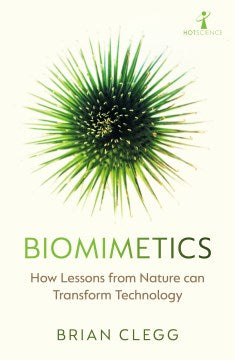
Biomimetics (Hot Science): How Lessons from Nature can Transform Technology
Publisher,Icon Books
Publication Date,
Format,
Weight, 420 g
No. of Pages, 176
An exploration of the transformative ways in which nature has inspired the technological advancement of humankind.
Biomimetics literally means emulating biology - and in a broader sense the term covers technological advances where the original inspiration came from nature. The Earth is a vast laboratory where the mechanisms of natural selection have enabled evolutionary solutions to be developed to a wide range of problems.
In this new title in the Hot Science series, science writer Brian Clegg looks at how humans have piggybacked on natural experimentation, redeploying a solution to create things that make our lives easier. He looks at how the hooks on burdock seeds inspired the creation of Velcro, how the stickiness of the feet of geckos and frogs has been used to create gripping surfaces, such as tyre treads, and how even the most basic optical enhancement in the form of spectacles is itself a form of biomimetics.
Review:
In this illuminating study, science writer Clegg (Lightning Often Strikes Twice) investigates how scientists and engineers take inspiration from nature. Highlighting inventions modeled on natural structures and processes, he tells how Swiss engineer George de Mestral got the idea for Velcro from the burrs stuck to his dog's fur; University of Akron graduate student Arnob Banik created tire treads modeled on the toe pads of tree frogs; and Dutch microbiologist Hendrik Jonkers developed a concrete mix featuring calcium carbonate-producing bacteria capable of filling cracks. Clegg also explores less successful attempts to harness the power of nature and details how Mercedes designed a bulky concept car resembling the build of a box fish, only to realize that "most of the fish's excellent ability to change direction and dart around came not from its shape... but from the unusual operation of its fins." Clegg is careful not to overhype biomimetic products (he expresses skepticism toward the claim of the Japanese company Teijin that its Morphotex fabric--which, like peacock tail feathers, gets its color from how its texture refracts light, rather than from pigmentation--somehow reduces textile waste), but he remains optimistic that the future might hold self-healing iPhone screens and greener energy production. Jam-packed with fascinating ideas, this is a treat for pop science readers. Publishers Weekly
About the Author:
Brian Clegg's many books include Dice World and A Brief History of Infinity, both longlisted for the Royal Society Science Book Prize, and, most recently, Ten Days in Physics That Shook the World

